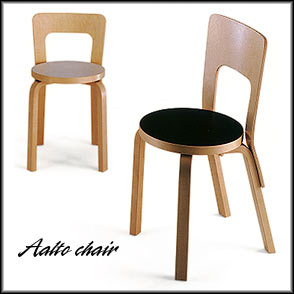Furniture and Glass: THE MUSEUM OF MODERN ART, NEW YORK
Alvar Aalto (1898 - 1976) is a Finnish architect and designer, who during his time created building, furniture and glassware. He is often thought of as "Father of Modernism" in Nordic countries.
The 1938 exhibition was devoted to Alvar Aalto and to his furniture design. Since that time, the Museum has shown an interest in collecting and displaying examples of his designs. Today, there are 20 pieces of his furniture in the Design Collection, which also include his glass and lighting fixtures.
In 1929, Alvar Aalto produced a side chair that could be easily massed produced. This chair was economical to produce and easy to store because of it's stacking ability. "His work was so appealing in its warmth, humanity, and unpretentious common sense that it was admired everywhere" ( Stewart 2).
Later on Aalto experimented with plywood and bonding layers of wood together in order to form different patterns and results. These investigations allowed Aalto to design a new seat "that extended the conventional L-shape at both top and bottom into bold volutes."(Stewart 4). This was important because it allowed him to get away from the traditional old frame where the chair relied on the four legs for support. Instead, the new frame suspended a spring seat that relied on sontinuous ribbons of wood, which was bent into approximate horizontal rectangles, the tops of which served as arm rests and the bottoms as skids. This new design gave Aalto recognition as a furniture designer and his new design was called "the first soft wooden chair."
Aside from wood, Aalto also experimented with metal. His tubular steel chair that he designed in 1930 was light and suitable for mass production. This design used the C-shape technique which could be upholstered or left bare.
Another design Aalto created was the L-leg chair, which allowed the legs to be fasted directly underside of the top. This allowed the top of the surface untouched as opposed to connecting the legs with screws that went through the top surface. Aalto achieved this by back-sawing the top of the leg and then inserting "leaves" of wood that were dipped in casein glue. Aalto's leg design was used for stools, tables and chairs. In addition, the L-leg was easy to mass produce at various sizes and was the most economical in furniture assembly.
His creations were simple and efficient, both in production and in use. "Aalto believed deeply in the need for standardization furniture design, but not at the expense of variety" (Stewart 13).


No comments:
Post a Comment